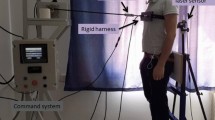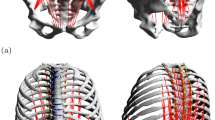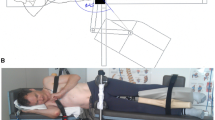Abstract
Biomechanical models of the spine either simplify intervertebral joints (using spherical joints or deformable beams) in musculoskeletal (MS) or overlook musculature in geometrically-detailed passive finite element (FE) models. These distinct active and passive models therefore fail to determine in vivo stresses and strains within and load-sharing among the joint structures (discs, ligaments, and facets). A novel hybrid active–passive spine model is therefore developed in which estimated trunk muscle forces from a MS model for in vivo activities drive a mechanically-equivalent passive FE model to quantify in vivo T12–S1 compression/shear loads, intradiscal pressures (IDP), centers of rotation (CoR), ligament/facet forces, and annulus fiber strains. The predicted and in vivo L4–L5 IDP and L1–S1 CoRs showed satisfactory agreements. The FE model under commonly-used in vitro loading (pure moments and follower loads) predicted different kinetics from those of the hybrid model under in vivo loads (muscle exertions and gravity loads) contributing to suggest the inadequacy of such in vitro loads when simulating in vivo tasks. For an improved assessment of the injury risk, evaluation of the internal loads, and design of implants, such hybrid models should therefore be used.








Similar content being viewed by others
References
Adams, M., and W. Hutton. Prolapsed intervertebral disc: a hyperflexion injury. Spine 7:184–191, 1982.
Akhavanfar, M., H. Kazemi, A. Eskandari, and N. Arjmand. Obesity and spinal loads: a combined MR imaging and subject-specific modeling investigation. J. Biomech. 70:102–112, 2018.
Arjmand, N., D. Gagnon, A. Plamondon, A. Shirazi-Adl, and C. Lariviere. Comparison of trunk muscle forces and spinal loads estimated by two biomechanical models. Clin. Biomech. 24:533–541, 2009.
Arjmand, N., D. Gagnon, A. Plamondon, A. Shirazi-Adl, and C. Lariviere. A comparative study of two trunk biomechanical models under symmetric and asymmetric loadings. J. Biomech. 43:485–491, 2010.
Arjmand N. Computational biomechanics of the human spine in static lifting tasks. PhD Thesis, Ecole Polytechnique de Montreal, pp. 218-220, 2006.
Arjmand, N., and A. Shirazi-Adl. Model and in vivo studies on human trunk load partitioning and stability in isometric forward flexions. J. Biomech. 39:510–521, 2006.
Arjmand, N., and A. Shirazi-Adl. Sensitivity of kinematics-based model predictions to optimization criteria in static lifting tasks. Med. Eng. Phys. 28:504–514, 2006.
Arjmand, N., A. Shirazi-Adl, and B. Bazrgari. Wrapping of trunk thoracic extensor muscles influences muscle forces and spinal loads in lifting tasks. Clin. Biomech. 21:668–675, 2006.
Azari, F., N. Arjmand, A. Shirazi-Adl, and T. Rahimi-Moghaddam. A combined passive and active musculoskeletal model study to estimate L4–L5 load sharing. J. Biomech. 70:157–165, 2018.
Bashkuev, M., P.-P. A. Vergroesen, M. Dreischarf, C. Schilling, A. J. van der Veen, H. Schmidt, and I. Kingma. Intradiscal pressure measurements: a challenge or a routine? J. Biomech. 49:864–868, 2016.
Bassani, T., E. Stucovitz, Z. Qian, M. Briguglio, and F. Galbusera. Validation of the AnyBody full body musculoskeletal model in computing lumbar spine loads at L4L5 level. J. Biomech. 58:89–96, 2017.
Breau, C., A. Shirazi-Adl, and J. De Guise. Reconstruction of a human ligamentous lumbar spine using CT images—a three-dimensional finite element mesh generation. Ann. Biomed. Eng. 19:291–302, 1991.
Brinckmann, P., and H. Grootenboer. Change of disc height, radial disc bulge, and intradiscal pressure from discectomy an in vitro investigation on human lumbar discs. Spine 16:641–646, 1991.
Bruno, A. G., M. L. Bouxsein, and D. E. Anderson. Development and validation of a musculoskeletal model of the fully articulated thoracolumbar spine and rib cage. J. Biomech. Eng. 137:081003, 2015.
Chen, C.-S., C.-K. Cheng, C.-L. Liu, and W.-H. Lo. Stress analysis of the disc adjacent to interbody fusion in lumbar spine. Med. Eng. Phys. 23:485–493, 2001.
Cholewicki, J., and S. M. McGill. Mechanical stability of the in vivo lumbar spine: implications for injury and chronic low back pain. Clin. Biomech. 11:1–15, 1996.
Damsgaard, M., J. Rasmussen, S. T. Christensen, E. Surma, and M. de Zee. Analysis of musculoskeletal systems in the anybody modeling system. Simul. Model. Pract. Theory 14:1100–1111, 2006.
Dittmar, R., M. M. van Rijsbergen, and K. Ito. Moderately degenerated human intervertebral disks exhibit a less geometrically specific collagen fiber orientation distribution. Global Spine J 6:439–446, 2016.
Dreischarf, M., A. Rohlmann, G. Bergmann, and T. Zander. Optimised loads for the simulation of axial rotation in the lumbar spine. J. Biomech. 44:2323–2327, 2011.
Dreischarf, M., A. Rohlmann, G. Bergmann, and T. Zander. Optimised in vitro applicable loads for the simulation of lateral bending in the lumbar spine. Med. Eng. Phys. 34:777–780, 2012.
Dreischarf, M., A. Shirazi-Adl, N. Arjmand, A. Rohlmann, and H. Schmidt. Estimation of loads on human lumbar spine: a review of in vivo and computational model studies. J. Biomech. 49:833–845, 2016.
Dreischarf, M., T. Zander, A. Shirazi-Adl, C. Puttlitz, C. Adam, C. Chen, V. Goel, A. Kiapour, Y. Kim, and K. Labus. Comparison of eight published static finite element models of the intact lumbar spine: Predictive power of models improves when combined together. J. Biomech. 47(8):1757–1766, 2014.
Ghezelbash, F., A. Eskandari, A. Shirazi-Adl, N. Arjmand, Z. El-Ouaaid, and A. Plamondon. Effects of motion segment simulation and joint positioning on spinal loads in trunk musculoskeletal models. J. Biomech. 70:149–156, 2018.
Ghezelbash, F., A. Shirazi-Adl, N. Arjmand, Z. El-Ouaaid, and A. Plamondon. Subject-specific biomechanics of trunk: musculoskeletal scaling, internal loads and intradiscal pressure estimation. Biomech. Model. Mechanobiol. 15:1699–1712, 2016.
Hajihosseinali, M., N. Arjmand, A. Shirazi-Adl, F. Farahmand, and M. Ghiasi. A novel stability and kinematics-driven trunk biomechanical model to estimate muscle and spinal forces. Med. Eng. Phys. 36:1296–1304, 2014.
Han, K.-S., A. Rohlmann, S.-J. Yang, B. S. Kim, and T.-H. Lim. Spinal muscles can create compressive follower loads in the lumbar spine in a neutral standing posture. Med. Eng. Phys. 33:472–478, 2011.
Heuer, F., H. Schmidt, L. Claes, and H.-J. Wilke. Stepwise reduction of functional spinal structures increase vertebral translation and intradiscal pressure. J. Biomech. 40:795–803, 2007.
Holzapfel, G. A., C. Schulze-Bauer, G. Feigl, and P. Regitnig. Single lamellar mechanics of the human lumbar anulus fibrosus. Biomech. Model. Mechanobiol. 3:125–140, 2005.
Ignasiak, D., S. J. Ferguson, and N. Arjmand. A rigid thorax assumption affects model loading predictions at the upper but not lower lumbar levels. J. Biomech. 49:3074–3078, 2016.
Kim, K., Y. H. Kim, and S. Lee. Investigation of optimal follower load path generated by trunk muscle coordination. J. Biomech. 44:1614–1617, 2011.
Little, J. P. Finite element modelling of anular lesions in the lumbar intervertebral disc. Brisbane: Queensland University of Technology, 2004.
Nachemson, A. Towards a better understanding of low-back pain: a review of the mechanics of the lumbar disc. Rheumatology 14:129–143, 1975.
Nachemson, A. L. Disc pressure measurements. Spine 6:93–97, 1981.
Nachemson, A., and G. Elfstrom. Intravital dynamic pressure measurements in lumbar discs. Scand J Rehabil 2:1–40, 1970.
Nachemson, A., and J. M. Morris. In vivo measurements of intradiscal pressure. J. Bone Joint Surg. 46:1077–1092, 1964.
Naserkhaki, S., N. Arjmand, A. Shirazi-Adl, F. Farahmand, and M. El-Rich. Effects of eight different ligament property datasets on biomechanics of a lumbar L4–L5 finite element model. J. Biomech. 70:33–42, 2018.
Naserkhaki, S., and M. El-Rich. Sensitivity of lumbar spine response to follower load and flexion moment: finite element study. Comput. Methods Biomech. Biomed. 20:550–557, 2017.
Naserkhaki, S., J. L. Jaremko, and M. El-Rich. Effects of inter-individual lumbar spine geometry variation on load-sharing: geometrically personalized finite element study. J. Biomech. 49:2909–2917, 2016.
Natarajan, R. N., and G. B. Andersson. The influence of lumbar disc height and cross-sectional area on the mechanical response of the disc to physiologic loading. Spine 24:1873, 1999.
Noailly, J., J. A. Planell, and D. Lacroix. On the collagen criss-cross angles in the annuli fibrosi of lumbar spine finite element models. Biomech. Model. Mechanobiol. 10:203–219, 2011.
Noailly, J., H.-J. Wilke, J. A. Planell, and D. Lacroix. How does the geometry affect the internal biomechanics of a lumbar spine bi-segment finite element model? Consequences on the validation process. J. Biomech. 40:2414–2425, 2007.
Okushima, H. Study on hydrodynamic pressure of lumbar intervertebral disc. Nihon geka hokan 39:45, 1970.
Park, W. M., K. Kim, and Y. H. Kim. Effects of degenerated intervertebral discs on intersegmental rotations, intradiscal pressures, and facet joint forces of the whole lumbar spine. Comput. Biol. 43:1234–1240, 2013.
Patwardhan, A. G., R. M. Havey, G. Carandang, J. Simonds, L. I. Voronov, A. J. Ghanayem, K. P. Meade, T. M. Gavin, and O. Paxinos. Effect of compressive follower preload on the flexion–extension response of the human lumbar spine. J. Orthop. Res. 21:540–546, 2003.
Pearcy, M. J. Stereo radiography of lumbar spine motion. Acta Orthop. Scand. 56:1–45, 1985.
Pearcy, M. J., and N. Bogduk. Instantaneous axes of rotation of the lumbar intervertebral joints. Spine 13:1033–1041, 1988.
Pearcy, M., I. Portek, and J. Shepherd. Three-dimensional x-ray analysis of normal movement in the lumbar spine. Spine 9:294–297, 1984.
Pearcy, M., and S. Tibrewal. Axial rotation and lateral bending in the normal lumbar spine measured by three-dimensional radiography. Spine 9:582–587, 1984.
Pearsall, D. J., J. G. Reid, and L. A. Livingston. Segmental inertial parameters of the human trunk as determined from computed tomography. Ann. Biomed. Eng. 24:198–210, 1996.
Polga, D. J., B. P. Beaubien, P. M. Kallemeier, K. P. Schellhas, W. D. Lew, G. R. Buttermann, and K. B. Wood. Measurement of in vivo intradiscal pressure in healthy thoracic intervertebral discs. Spine 29:1320–1324, 2004.
Potvin, J. Use of NIOSH equation inputs to calculate lumbosacral compression forces. Ergonomics 40:691–707, 1997.
Rajaee, M. A., N. Arjmand, A. Shirazi-Adl, A. Plamondon, and H. Schmidt. Comparative evaluation of six quantitative lifting tools to estimate spine loads during static activities. Appl. Ergon. 48:22–32, 2015.
Rajasekaran, S., N. Bajaj, V. Tubaki, R. M. Kanna, and A. P. Shetty. ISSLS prize winner: the anatomy of failure in lumbar disc herniation: an in vivo, multimodal, prospective study of 181 subjects. Spine 38:1491–1500, 2013.
Rohlmann, A., U. Arntz, F. Graichen, and G. Bergmann. Loads on an internal spinal fixation device during sitting. J. Biomech. 34:989–993, 2001.
Rohlmann, A., L. Bauer, T. Zander, G. Bergmann, and H.-J. Wilke. Determination of trunk muscle forces for flexion and extension by using a validated finite element model of the lumbar spine and measured in vivo data. J. Biomech. 39:981–989, 2006.
Rohlmann, A., G. Bergmann, and F. Graichen. Loads on internal spinal fixators measured in different body positions. Eur. Spine J. 8:354–359, 1999.
Rohlmann, A., S. Neller, L. Claes, G. Bergmann, and H.-J. Wilke. Influence of a follower load on intradiscal pressure and intersegmental rotation of the lumbar spine. Spine 26:E557–E561, 2001.
Rohlmann, A., R. Petersen, V. Schwachmeyer, F. Graichen, and G. Bergmann. Spinal loads during position changes. Clin. Biomech. 27:754–758, 2012.
Rohlmann, A., T. Zander, F. Graichen, M. Dreischarf, and G. Bergmann. Measured loads on a vertebral body replacement during sitting. Spine J. 11:870–875, 2011.
Rohlmann, A., T. Zander, M. Rao, and G. Bergmann. Realistic loading conditions for upper body bending. J. Biomech. 42:884–890, 2009.
Sato, K., S. Kikuchi, and T. Yonezawa. In vivo intradiscal pressure measurement in healthy individuals and in patients with ongoing back problems. Spine 24:2468, 1999.
Schultz, A., G. Andersson, R. Ortengren, K. Haderspeck, and A. Nachemson. Loads on the lumbar spine: validation of a biomechanical analysis by measurements of intradiscal pressures and myoelectric signals. JBJS 64:713–720, 1982.
Shiraz-Adl, A. Strain in fibers of a lumbar disc: analysis of the role of lifting in producing disc prolapse. Spine 14:96–103, 1989.
Shirazi-Adl, A. Biomechanics of the lumbar spine in sagittal/lateral moments. Spine 19:2407–2414, 1994.
Shirazi-Adl, A. Analysis of large compression loads on lumbar spine in flexion and in torsion using a novel wrapping element. J. Biomech. 39:267–275, 2006.
Shirazi-Adl, A., A. M. Ahmed, and S. C. Shrivastava. Mechanical response of a lumbar motion segment in axial torque alone and combined with compression. Spine 11:914–927, 1986.
Shirazi-Adl, A., and M. Parnianpour. Load-bearing and stress analysis of the human spine under a novel wrapping compression loading. Clin. Biomech. 15:718–725, 2000.
Shirazi-adl, S. A., S. C. Shrivastava, and A. M. Ahmed. Stress analysis of the lumbar disc-body unit in compression a three-dimensional nonlinear finite element study. Spine 9:120–134, 1984.
Stemper, B. D., J. L. Baisden, N. Yoganandan, B. S. Shender, and D. J. Maiman. Mechanical yield of the lumbar annulus: a possible contributor to instability. J. Neurosurg. Spine 21:608–613, 2014.
Stokes, I. A., and M. Gardner-Morse. Lumbar spine maximum efforts and muscle recruitment patterns predicted by a model with multijoint muscles and joints with stiffness. J. Biomech. 28:173177–175186, 1995.
Stokes, I. A., and M. Gardner-Morse. Quantitative anatomy of the lumbar musculature. J. Biomech. 32:311–316, 1999.
Van Dieen, J., and I. Kingma. Effects of antagonistic co-contraction on differences between electromyography based and optimization based estimates of spinal forces. Ergonomics 48:411–426, 2005.
Wade, K. R., P. A. Robertson, A. Thambyah, and N. D. Broom. How healthy discs herniate: a biomechanical and microstructural study investigating the combined effects of compression rate and flexion. Spine 39:1018–1028, 2014.
Wade, K., P. Robertson, A. Thambyah, and N. Broom. “Surprise” loading in flexion increases the risk of disc herniation due to annulus–endplate junction failure: a mechanical and microstructural investigation. Spine 40(12):891–901, 2015.
Wilke, H. J., P. Neef, M. Caimi, T. Hoogland, and L. E. Claes. New in vivo measurements of pressures in the intervertebral disc in daily life. Spine 24:755–762, 1999.
Wilke, H.-J., P. Neef, B. Hinz, H. Seidel, and L. Claes. Intradiscal pressure together with anthropometric data–a data set for the validation of models. Clin. Biomech. 16:S111–S126, 2001.
Xia, Q., S. Wang, M. Kozanek, P. Passias, K. Wood, and G. Li. In-vivo motion characteristics of lumbar vertebrae in sagittal and transverse planes. J. Biomech. 43:1905–1909, 2010.
Zander, T., M. Dreischarf, A.-K. Timm, W. W. Baumann, and H. Schmidt. Impact of material and morphological parameters on the mechanical response of the lumbar spine—a finite element sensitivity study. J. Biomech. 53:185–190, 2017.
Zhu, D., G. Gu, W. Wu, H. Gong, W. Zhu, T. Jiang, and Z. Cao. Micro-structure and mechanical properties of annulus fibrous of the L4–5 and L5–S1 intervertebral discs. Clin. Biomech. 23:S74–S82, 2008.
Acknowledgments
This work was supported by grants from Sharif University of Technology (Tehran, Iran). Assistance of Mr. H. Asadi and Dr. S. Naserkhaki in the finite element modeling and Mr. A.H. Eskandari in the musculoskeletal modeling is greatly appreciated.
Author information
Authors and Affiliations
Corresponding author
Additional information
Associate Editor Thurmon E. Lockhart oversaw the review of this article.
Electronic supplementary material
Below is the link to the electronic supplementary material.
Rights and permissions
About this article
Cite this article
Khoddam-Khorasani, P., Arjmand, N. & Shirazi-Adl, A. Trunk Hybrid Passive–Active Musculoskeletal Modeling to Determine the Detailed T12–S1 Response Under In Vivo Loads. Ann Biomed Eng 46, 1830–1843 (2018). https://doi.org/10.1007/s10439-018-2078-7
Received:
Accepted:
Published:
Issue Date:
DOI: https://doi.org/10.1007/s10439-018-2078-7




